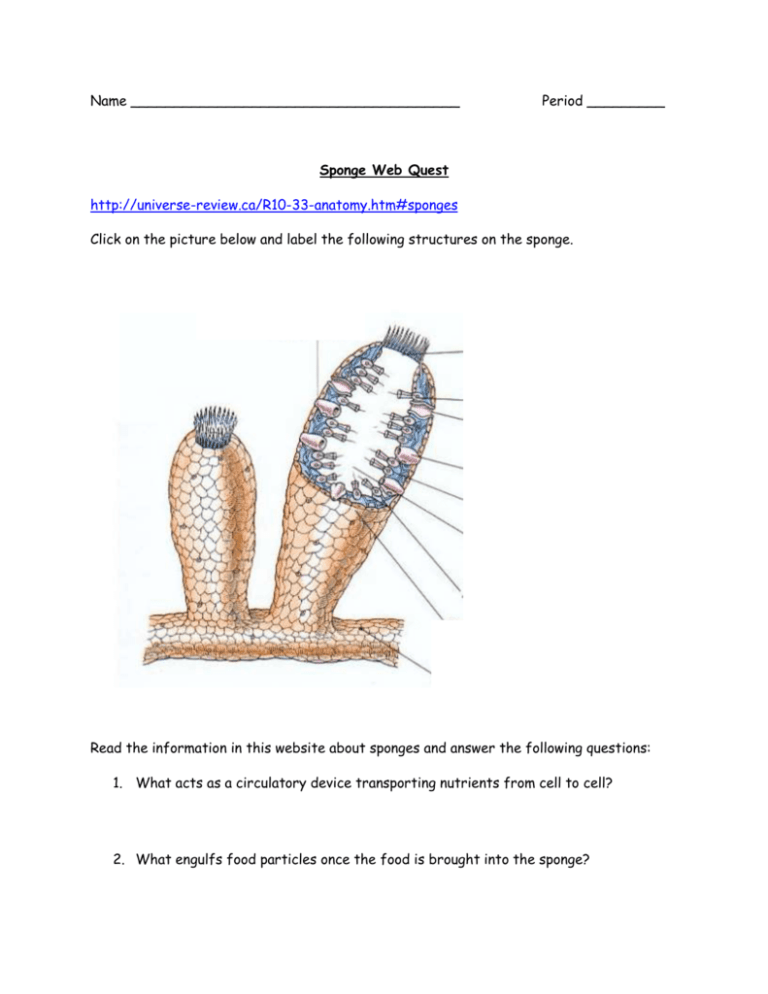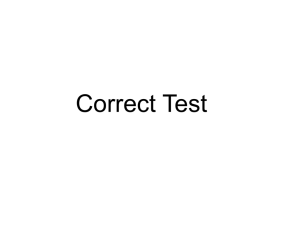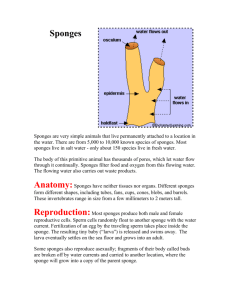Name ______ Period ______ Sponge Web Quest http://universe
advertisement

Name ______________________________________ Period _________ Sponge Web Quest http://universe-review.ca/R10-33-anatomy.htm#sponges Click on the picture below and label the following structures on the sponge. Read the information in this website about sponges and answer the following questions: 1. What acts as a circulatory device transporting nutrients from cell to cell? 2. What engulfs food particles once the food is brought into the sponge? 3. One way food is digested is by food vacuoles. What other way can food be digested? 4. What type of cells produce water currents with its flagella? 5. What is the gelatinous layer found between the outer body of the sponge and the spongocoel? 6. The tiny needle like splinters that make up the skeleton of the sponge are called ____________. Go to the website below: http://www.infusion.allconet.org/webquest/PhylumPorifera.html 1. What kingdom and phylum do sponges belong to? 2. What does it mean to be sessile? 3. What are the three different classes of sponges? Identify the material that makes up the spicules of each class. 4. Asexual reproduction in sponges occurs two different ways. Describe the two ways below: 5. Sponges also reproduce sexually. Where does fertilzation occur in sponges? 6. Why is being an hermaphrodite an advantage for a sponge? Go to the website Below: http://www.ucmp.berkeley.edu/porifera/porifera.html 1. Describe how sponges obtain food. 2. What determies the direction of water flow in sponges? Click on the different classes to answer the questions below: 3. Hexactinellids are also referred to as _________________. 4. Which class of sponges is most diverse? 5. What type of organization (canal system) make up Demospongia sponges? Go to the website below: http://library.thinkquest.org/03oct/00647/id17.htm Read: SPONG BASICS 1. Which class of sponges are found in deep seas of the world and have a glassy texture? 2. Which class of sponges make up 95% of all sponges including the bath sponge? Read: WHAT’S FOR DINNER 1. Where do organisms enter the sponge? 2. What structure captures the microorganisms inside the sponge? 3. Where does water exit the sponge? Read: BELIVE IT OR NOT 1. Read the list of sponge facts. List four facts you think are the most interesting in the list. Read: CANCER CURE 1. What do sponges have that may be a cure to cancer? 2. What does this sponge produce that may help cure cancer? 3. What is the problem with this idea? Read: SYNTHETIC VS. NATURAL 1. What are humans doing (other than cultivating) that may result in the loss of sponge growth? Read: SPONGES FOR SALE 1. How many species of sponges are considered marketable? 2. What are some benefits of using a natural sponge over a synthetic sponge? (give 3) 3. Other than hygiene, what are natural sponges used for?






